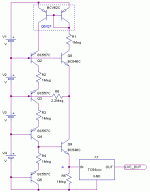I've been toying around with current-mode chaining of LVC circuits in the simulator recently and realized that you can build a super-cheap LVC using just one TC54 chip and current mode transistor chain as a sensor/aggregator. It will not have the same threshold accuracy and temperature stability as multiple TC54 circuit but it is not really needed for LVC-only circuit. The circuit allows building sub $1 LVC-only device (excluding board cost).
Few notes:
1. R1 has a smaller value because top segment of the chain connects directly to the cell, not to the collector of another transistor above (which can have higher potential than corresponding cell by Vbe-Vce_sat). By properly selecting R1 threshold of the top cell can be made equal to other cells (even though measurement slope will be slightly different).
2. Q4 buffers very high-Z output of the measurement chain.
3. D1 can be replaced with another transistor in a diode arrangement.
4. With some rearrangement the circuit can be thermally compensated. I did not do it here for readability/simplicity reasons and also not convinced it is needed in real life.
5. A high impedance voltmeter attached to the anode of D1 or emitter of Q4 gives you approximate readout of the lowest voltage cell (with proper resistor choice and scaling).
Few notes:
1. R1 has a smaller value because top segment of the chain connects directly to the cell, not to the collector of another transistor above (which can have higher potential than corresponding cell by Vbe-Vce_sat). By properly selecting R1 threshold of the top cell can be made equal to other cells (even though measurement slope will be slightly different).
2. Q4 buffers very high-Z output of the measurement chain.
3. D1 can be replaced with another transistor in a diode arrangement.
4. With some rearrangement the circuit can be thermally compensated. I did not do it here for readability/simplicity reasons and also not convinced it is needed in real life.
5. A high impedance voltmeter attached to the anode of D1 or emitter of Q4 gives you approximate readout of the lowest voltage cell (with proper resistor choice and scaling).


